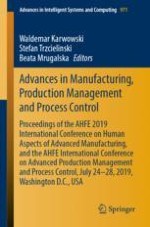2020 | Book
Advances in Manufacturing, Production Management and Process Control
Proceedings of the AHFE 2019 International Conference on Human Aspects of Advanced Manufacturing, and the AHFE International Conference on Advanced Production Management and Process Control, July 24-28, 2019, Washington D.C., USA
Editors: Prof. Waldemar Karwowski, Stefan Trzcielinski, Dr. Beata Mrugalska
Publisher: Springer International Publishing
Book Series : Advances in Intelligent Systems and Computing
